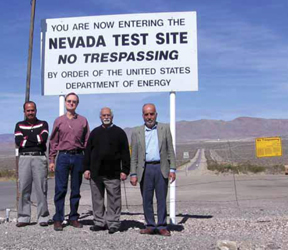
Sandia scientists are helping train Iraqi scientists and technicians to clean up radioactively contaminated sites and safely dispose of the radioactive wastes as part of the Iraqi Nuclear Facility Dismantlement and Disposal Program.
The Sandia work is a technical transfer of skills and knowledge that the Labs use day to day, says principal investigator John Cochran (6765). As an example of this, Sandia has transferred its Rad Worker II training materials to the government of Iraq.
The Iraqi Nuclear Facility Dismantlement and Disposal Program (the Iraqi NDs Program) was initiated by the US Department of State to assist Iraq in eliminating the threats from poorly controlled radioactive materials, John says. The current activities build on two years of cooperative efforts coordinated by the International Atomic Energy Agency in Vienna with support by donor countries. The State Department is coordinating the US government assistance from Sandia, DOE, Texas Tech University, the Environmental Protection Agency, the Nuclear Regulatory Commission, and others.
Iraqi area of concern
The program focuses on the Al Tuwaitha nuclear complex near Baghdad, which contains major facilities left from Saddam Hussein’s dictatorship. The nuclear complex covers more than a square kilometer and includes the remains of two research reactors, a fuel fabrication facility, plutonium separation facilities, and other infrastructure. The Osiraq research reactor at Al Tuwaitha was bombed by Israel in 1981 and the IRT-5000 research reactor was bombed and disabled during Operation Desert Storm in 1991.
In 2003, following Operation Iraqi Freedom, looters removed contaminated scrap metal and dozens of 50-gallon barrels that contained yellowcake uranium. The looters poured yellowcake on the ground and in the waterways surrounding Al Tuwaitha and on the village outskirts. Today, the site contains uncharacterized radioactive wastes, waste uranium compounds related to yellowcake, sealed radioactive sources, and activated metals. There are also other sites in the country that have some degree of contamination and will require decommissioning and remediation to ensure radiological safety, John says.
The fresh nuclear fuel, spent nuclear fuel, and enriched uranium have been removed from the country, along with approximately 1,000 radioactive sealed sources.
The sites that previously housed Iraq’s nuclear facilities remain in a radioactively contaminated and hazardous condition. Since Iraq has generated radioactive waste for more than 50 years, and because the country has never had a licensed radioactive waste disposal facility, there are relatively large quantities of radioactive waste and material in guarded storage. John says Iraq has no national strategy or system for radioactive waste management.
Sandia’s role
Sandia provides consultation, training tours, and hands-on demonstrations to Iraqi professionals from the Iraqi regulatory authority, the owner of the Al Tuwaitha complex (the Ministry of Science and Technology), and the Ministry of Environment. The cleanup of a bombed and looted nuclear complex is unique, with no direct analogues in the US, John says.
The Iraqi NDs work is focused on characterization, cleanup, dismantling nuclear facilities, waste management, and waste disposal.
Touring US sites
As part of the project, Sandia researchers took Iraqi scientists on tours through two operating radioactive waste disposal facilities with climatic and geohydrologic conditions similar to those in Iraq. The first site visited was the Nevada Test Site (NTS) and the second was a radioactive waste disposal facility operated by EnergySolutions Inc. located near Clive, Utah.
At NTS, the Iraqis learned about disposal of radioactive wastes in trenches and in 36-meter-deep augered shafts known as greater confinement disposal (GCD) boreholes. John had led a 10-year study of the ability of the GCD boreholes to isolate long-lived transuranic wastes. The security at NTS required significant coordination and support from DOE’s Nevada Field Office.
Sandia has also provided training in the fundamentals of project management, radiological waste management, and the laws governing safe disposal of radioactive waste in America.
“On-the-ground progress is the focus of the training,” John says. “Iraq has budgeted $10 million to the project, and on July 1 the Ministry of Science and Technology began cleaning up the Active Metallurgy Testing Laboratory at Al Tuwaitha.”
Another purpose of the work is to help make radioactive waste management work real and interesting to the scientists who were isolated from their counterparts for more than a decade by United Nations sanctions.
John says professional relationships have been forged between Iraqis and national and international waste management experts.
“This is a modest international program that has an important effect,” says David Kenagy, the US State Department official who is the sponsor of the work. “The project is going very well.”
Other Sandia team members include: Bill Arnold (6781), Jeff Danneels (6761), Carolyn Daniel (6034), Stacy Griffith (6765), Sid Gutierrez (6700), Marvin Hadley (4128), John Inman (4128), Franz Lauffer (4133), David Miller (6765), Joe Schelling (6772), Brian Thomson (4128) and Anisha Quiroz (6051).